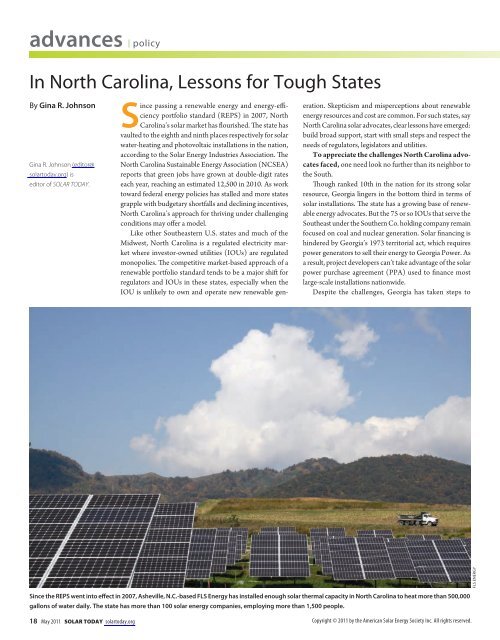SOLAR TODAY - May 2011 - Innovative Design
SOLAR TODAY - May 2011 - Innovative Design
SOLAR TODAY - May 2011 - Innovative Design
Create successful ePaper yourself
Turn your PDF publications into a flip-book with our unique Google optimized e-Paper software.
advances<br />
| policy<br />
In North Carolina, Lessons for Tough States<br />
By Gina R. Johnson<br />
Gina R. Johnson (editor@<br />
solartoday.org) is<br />
editor of <strong>SOLAR</strong> <strong>TODAY</strong>.<br />
Since passing a renewable energy and energy-efficiency<br />
portfolio standard (REPS) in 2007, North<br />
Carolina’s solar market has flourished. The state has<br />
vaulted to the eighth and ninth places respectively for solar<br />
water-heating and photovoltaic installations in the nation,<br />
according to the Solar Energy Industries Association. The<br />
North Carolina Sustainable Energy Association (NCSEA)<br />
reports that green jobs have grown at double-digit rates<br />
each year, reaching an estimated 12,500 in 2010. As work<br />
toward federal energy policies has stalled and more states<br />
grapple with budgetary shortfalls and declining incentives,<br />
North Carolina’s approach for thriving under challenging<br />
conditions may offer a model.<br />
Like other Southeastern U.S. states and much of the<br />
Midwest, North Carolina is a regulated electricity market<br />
where investor-owned utilities (IOUs) are regulated<br />
monopolies. The competitive market-based approach of a<br />
renewable portfolio standard tends to be a major shift for<br />
regulators and IOUs in these states, especially when the<br />
IOU is unlikely to own and operate new renewable generation.<br />
Skepticism and misperceptions about renewable<br />
energy resources and cost are common. For such states, say<br />
North Carolina solar advocates, clear lessons have emerged:<br />
build broad support, start with small steps and respect the<br />
needs of regulators, legislators and utilities.<br />
To appreciate the challenges North Carolina advocates<br />
faced, one need look no further than its neighbor to<br />
the South.<br />
Though ranked 10th in the nation for its strong solar<br />
resource, Georgia lingers in the bottom third in terms of<br />
solar installations. The state has a growing base of renewable<br />
energy advocates. But the 75 or so IOUs that serve the<br />
Southeast under the Southern Co. holding company remain<br />
focused on coal and nuclear generation. Solar financing is<br />
hindered by Georgia’s 1973 territorial act, which requires<br />
power generators to sell their energy to Georgia Power. As<br />
a result, project developers can’t take advantage of the solar<br />
power purchase agreement (PPA) used to finance most<br />
large-scale installations nationwide.<br />
Despite the challenges, Georgia has taken steps to<br />
FLS Energy<br />
Since the REPS went into effect in 2007, Asheville, N.C.-based FLS Energy has installed enough solar thermal capacity in North Carolina to heat more than 500,000<br />
gallons of water daily. The state has more than 100 solar energy companies, employing more than 1,500 people.<br />
18 <strong>May</strong> <strong>2011</strong> <strong>SOLAR</strong> <strong>TODAY</strong> solartoday.org Copyright © <strong>2011</strong> by the American Solar Energy Society Inc. All rights reserved.









